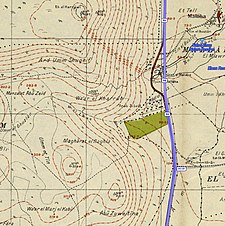Arab al-Zubayd
Today, we want to dedicate a space to talk about Arab al-Zubayd, a topic that has gained relevance in recent times. Arab al-Zubayd is an issue that concerns us all, since it has a direct impact on our lives. Throughout this article, we will explore different aspects and perspectives related to Arab al-Zubayd, with the aim of providing a comprehensive and complete vision on this topic. We will address its importance, its evolution over time, its implications in current society and its future projection. Without a doubt, Arab al-Zubayd is a fascinating topic that invites us to reflect and analyze its influence on our personal and collective contexts.
Arab al-Zubayd
عرب الزبيد | |
|---|---|
Village | |
| Etymology: The Zubeid Arabs | |
A series of historical maps of the area around Arab al-Zubayd (click the buttons) | |
Location within Mandatory Palestine | |
| Coordinates: 33°4′44″N 35°34′03″E / 33.07889°N 35.56750°E | |
| Palestine grid | 203/276 |
| Geopolitical entity | Mandatory Palestine |
| Subdistrict | Safad |
| Date of depopulation | April 20, 1948 |
| Population (1945) | |
| • Total | 890 |
| Cause(s) of depopulation | Fear of being caught up in the fighting |
Arab al-Zubayd was a Palestinian village in the Safad Subdistrict. It was depopulated during the 1947–1948 Civil War in Mandatory Palestine on April 20, 1948, when the villagers fled on hearing the intentions of The Palmach's First Battalion of Operation Yiftach. It was located 15 km northeast of Safad, near the al-Mutilla-Safad—Tiberias highway.
History
In 1838, in the Ottoman era, ez-Zubeid was noted as an Arab tribe, within the Government of Safad.
British Mandate era
In the 1922 census of Palestine conducted by the British Mandate authorities, Arab Zubaid had a population of 257; 255 Muslims and 2 Melkite Christians, increasing in the 1931 census, when it was counted together with Al-'Ulmaniyya, to 432; 5 Christians and 427 Muslims, in a total of 100 houses.
The population, combined with that of Mallaha, came to 890 Muslims in the 1945 statistics, with a total of 2,168 dunams of land.
The village had many springs for its water source, and farming was the main occupation. In 1944–45 a total of 1,761 dunums was allocated to cereal farming. while 20 dunams were classified as built-up land.
1948 war and depopulation
Israeli historian Benny Morris has found evidence that the population fled on 20 April (prior to the occupation of any of the neighboring villages), anticipating an Israeli attack. In August 1948, Golani Brigade units were preparing to blow up the village in spite of a complaint from the nearby Kibbutz Sha’ar ha-’Amaqim, who objected. Prime Minister David Ben-Gurion denied responsibility, saying: "No permission was given by me or to any commander to destroy houses." The village was nevertheless destroyed.
In 1992 the village site was described: "All that remains of ‘Ara al-Zubayed is scattered rubble, buried under a thicket of woods, grass, and thorny plants. Irrigation works tap the village’s water resources. Animals graze in the mountainous portions of the land near the site. Some land in the plain that borders the site has been converted into an Israeli nature reserve, while the rest is cultivated by Israeli farmers."
Notes and references
- ^ a b Morris, 2004, p. xvi, village #31. Also gives cause of depopulation.
- ^ Palmer, 1881, p. 67
- ^ a b Government of Palestine, Department of Statistics, 1945, p. 10
- ^ a b Government of Palestine, Department of Statistics. Village Statistics, April, 1945. Quoted in Hadawi, 1970, p. 70
- ^ a b c Khalidi, 1992, p.435.
- ^ Robinson and Smith, 1841, vol 3, Appendix 2, p. 134
- ^ Barron, 1923, Table XI, Sub-district of Safad, p. 42
- ^ Barron, 1923, table XV, p. 51
- ^ Mills, 1932, p. 111
- ^ Government of Palestine, Department of Statistics. Village Statistics, April, 1945. Quoted in Hadawi, 1970, p. 119
- ^ Government of Palestine, Department of Statistics. Village Statistics, April, 1945. Quoted in Hadawi, 1970, p. 169
- ^ a b c d Khalidi, 1992, p. 436
Bibliography
- Barron, J.B., ed. (1923). Palestine: Report and General Abstracts of the Census of 1922. Government of Palestine.
- Government of Palestine, Department of Statistics (1945). Village Statistics, April, 1945.
- Hadawi, S. (1970). Village Statistics of 1945: A Classification of Land and Area ownership in Palestine. Palestine Liberation Organization Research Center.
- Khalidi, W. (1992). All That Remains: The Palestinian Villages Occupied and Depopulated by Israel in 1948. Washington D.C.: Institute for Palestine Studies. ISBN 0-88728-224-5.
- Mills, E., ed. (1932). Census of Palestine 1931. Population of Villages, Towns and Administrative Areas. Jerusalem: Government of Palestine.
- Morris, B. (2004). The Birth of the Palestinian Refugee Problem Revisited. Cambridge University Press. ISBN 978-0-521-00967-6.
- Palmer, E.H. (1881). The Survey of Western Palestine: Arabic and English Name Lists Collected During the Survey by Lieutenants Conder and Kitchener, R. E. Transliterated and Explained by E.H. Palmer. Committee of the Palestine Exploration Fund.
- Robinson, E.; Smith, E. (1841). Biblical Researches in Palestine, Mount Sinai and Arabia Petraea: A Journal of Travels in the year 1838. Vol. 3. Boston: Crocker & Brewster.
External links
- Welcome To 'Arab al-Zubayd
- 'Arab al-Zubayd, Zochrot
- 'Arab al-Zubayd at Khalil Sakakini Cultural Center
- 'Arab al-Zubayd, Dr. Khalil Rizk.
- Survey of Western Palestine, Map 4: IAA, Wikimedia commons





